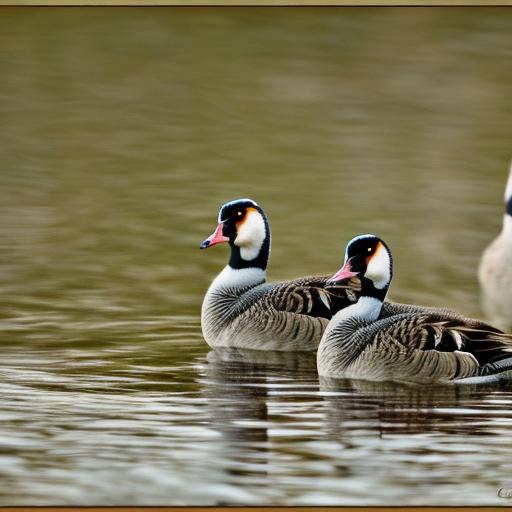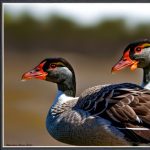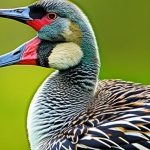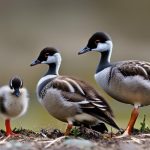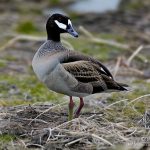Geese are fascinating creatures that have captured the attention of humans for centuries. They are known for their distinctive honking calls, V-shaped flight formations, and strong family bonds. However, in recent years, the interbreeding of geese has become a topic of interest and concern among researchers and conservationists. Interbreeding occurs when different species or subspecies of geese mate and produce offspring with mixed genetic traits. This phenomenon has raised questions about the impact on geese populations, genetic diversity, and the role of human activity in influencing interbreeding. In this article, we will explore the behavior and biology of geese, the impact of interbreeding on geese populations, the role of human activity in interbreeding, the genetic diversity of interbred geese, their adaptability, conservation and management efforts, the future of interbred geese, and the ethical considerations surrounding interbreeding.
The Behavior and Biology of Geese
Geese are highly social birds that form strong pair bonds and exhibit complex communication and social behaviors. They are known for their migratory patterns, with some species traveling thousands of miles each year to reach their breeding and wintering grounds. Geese are also herbivorous, feeding on a variety of grasses, grains, and aquatic plants. They are monogamous, with pairs often staying together for life and raising their young as a family unit. Geese are also known for their aggressive behavior when defending their nests and territories, often engaging in loud honking and physical displays to ward off potential threats. Understanding the behavior and biology of geese is crucial in assessing the impact of interbreeding on their populations and genetic diversity.
The Impact of Interbreeding on Geese Populations
The interbreeding of geese can have significant implications for their populations and genetic diversity. When different species or subspecies of geese interbreed, it can result in hybrid offspring with a mix of genetic traits from each parent species. While some hybrids may exhibit favorable traits such as increased adaptability to different environments, others may suffer from reduced fitness and reproductive success. Interbreeding can also lead to the dilution of genetic diversity within geese populations, potentially making them more vulnerable to environmental changes and disease. Additionally, the introduction of hybrid geese into new habitats can disrupt local ecosystems and lead to competition with native species for resources. Conservationists and researchers are closely monitoring the impact of interbreeding on geese populations to develop strategies for managing and preserving their genetic diversity.
The Role of Human Activity in Interbreeding
Human activity has played a significant role in influencing the interbreeding of geese. Habitat destruction, climate change, and the introduction of non-native species have all contributed to the disruption of natural breeding patterns and the mixing of different geese populations. In some cases, human intervention has led to the intentional or unintentional release of captive-bred geese into the wild, resulting in the interbreeding of domestic and wild populations. Hunting and poaching of geese have also impacted their populations, leading to changes in their genetic diversity and breeding behaviors. As human activity continues to shape the environment and influence geese populations, it is essential to consider the implications of interbreeding and develop sustainable management practices to mitigate its effects.
The Genetic Diversity of Interbred Geese
The genetic diversity of interbred geese is a complex and dynamic aspect of their populations. Interbreeding can result in a wide range of genetic combinations, leading to variations in physical traits, behavior, and adaptability. While some hybrid geese may exhibit traits that are advantageous in certain environments, others may face challenges in finding suitable mates and establishing successful breeding territories. The genetic diversity of interbred geese also raises questions about their long-term viability and ability to adapt to changing environmental conditions. Conservation efforts are focused on understanding the genetic diversity of interbred geese and identifying strategies to preserve and manage their populations in the face of ongoing interbreeding.
The Adaptability of Interbred Geese
Interbred geese have demonstrated remarkable adaptability to a variety of habitats and environmental conditions. Their mixed genetic traits can provide them with a broader range of physical and behavioral characteristics, allowing them to thrive in diverse ecosystems. Hybrid geese may exhibit traits such as increased disease resistance, tolerance to extreme temperatures, and the ability to exploit new food sources. However, the adaptability of interbred geese is not without its challenges. Some hybrids may struggle to find suitable mates and establish successful breeding territories, leading to reduced reproductive success and genetic isolation. Understanding the adaptability of interbred geese is essential in developing conservation and management strategies that support their long-term survival and genetic diversity.
The Conservation and Management of Interbred Geese
Conservation and management efforts for interbred geese are focused on preserving their genetic diversity, maintaining healthy populations, and minimizing the impact of interbreeding on native species. This includes monitoring the distribution and abundance of interbred geese, identifying key breeding and wintering habitats, and implementing measures to protect and restore their natural environments. Conservationists are also working to raise awareness about the importance of genetic diversity and the role of interbred geese in maintaining healthy ecosystems. Management strategies may include habitat restoration, population monitoring, and the development of sustainable hunting and harvesting practices. By taking a proactive approach to conservation and management, it is possible to ensure the long-term viability of interbred geese and their contribution to the diversity of avian species.
The Future of Interbred Geese
The future of interbred geese is a topic of ongoing research and debate among conservationists and researchers. As human activity continues to shape the environment and influence geese populations, it is essential to consider the long-term implications of interbreeding on their genetic diversity and adaptability. Conservation efforts are focused on understanding the factors that influence interbreeding, developing strategies to manage and preserve the genetic diversity of interbred geese, and promoting sustainable coexistence with native species. By embracing the diversity of interbred geese and recognizing their unique contributions to avian populations, it is possible to ensure their continued presence in the natural world.
The Ethical Considerations of Interbreeding
The interbreeding of geese raises important ethical considerations regarding the impact on their populations, genetic diversity, and natural habitats. Conservationists and researchers are grappling with questions about the potential consequences of interbreeding, the role of human activity in influencing genetic diversity, and the ethical implications of managing interbred geese populations. It is essential to consider the welfare of interbred geese and their role in maintaining healthy ecosystems, while also recognizing the complex interactions between human activity and natural processes. By addressing these ethical considerations, it is possible to develop sustainable management practices that support the long-term survival and genetic diversity of interbred geese.
Embracing the Diversity of Geese
In conclusion, the interbreeding of geese is a complex and dynamic phenomenon that has significant implications for their populations, genetic diversity, and adaptability. Understanding the behavior and biology of geese, the impact of interbreeding on their populations, the role of human activity in influencing interbreeding, the genetic diversity of interbred geese, their adaptability, conservation and management efforts, the future of interbred geese, and the ethical considerations surrounding interbreeding is essential in developing strategies to support their long-term survival and genetic diversity. By embracing the diversity of interbred geese and recognizing their unique contributions to avian populations, it is possible to ensure their continued presence in the natural world. Conservationists, researchers, and policymakers must work together to address the challenges and opportunities presented by interbreeding, and to develop sustainable management practices that support the welfare of interbred geese and their role in maintaining healthy ecosystems.
Meet Walter, the feathered-friend fanatic of Florida! Nestled in the sunshine state, Walter struts through life with his feathered companions, clucking his way to happiness. With a coop that’s fancier than a five-star hotel, he’s the Don Juan of the chicken world. When he’s not teaching his hens to do the cha-cha, you’ll find him in a heated debate with his prized rooster, Sir Clucks-a-Lot. Walter’s poultry passion is no yolk; he’s the sunny-side-up guy you never knew you needed in your flock of friends!

